It’s December! Which means all I want to do these days is bake Christmas cookies and post about them. But, while that’s definitely coming, I felt like I needed to do a post first on this Korean staple (again, all about the blog staples!) because it’s so essential in some of the recipes I’ve posted, and because I’ve already been talking to so many of you about it in comments. So I’m resisting the ginger snaps, cranberries, and peppermint extract for now (so hard!), and sharing with you all my (limited) experiences with making homemade kimchi.
Before I start, I want to be clear that I am absolutely no kimchi-making expert. For that, you need to turn to Maangchi’s all-knowing kimchi wizardry. But given that I was working from no experience and managed to make kimchi from her recipe fairly successfully, I figure I’m about as good a person as any to advise those who are similarly clueless. 🙂 The recipe below is based on her “mak kimchi” recipe, meaning “easy kimchi” (I found the title promising), and I went with it because Maangchi’s recipes have been no-fail thus far. It was also very similar to what Bowl #2’s very Korean uncle recommended — and he prides himself on his kimchi! I was extremely pleased with the results. We had it both fresh and in everything I make with kimchi (kimchi fried rice, bindaetteok, etc.) and it tasted on point. At the very least, it was a big improvement on storebought and far cheaper, which was all I was aiming for. (With the quality of storebought kimchi in the Northeast, it’s a low bar.)
The most traditional way of fermenting cabbage kimchi is keeping the head of cabbage whole — and you can see in stores that it’s sold both as whole heads and diced. But making kimchi the traditional way requires at least overnight salting before you begin fermenting it in the kimchi paste, not to mention having large enough containers and storage space to hold a whole head of cabbage. So this method is called mak, or easy, kimchi, and it requires only a few hours of salting, by comparison. I’ve seen other translations that say it’s “carelessly made” kimchi.
You’ll start by chopping the head into fourths and then bite-sized pieces, cutting out the core:
Then comes a very important process — salting the kimchi. This is perhaps the hardest thing to get right in the kimchi-making process, because not salty enough means it won’t ferment properly and will go bad, and too salty is … well, too salty. I’ve seen recommendations of about a teaspoon for every handful of cabbage and about 1/2 cup (from Maangchi) for 5 lbs (two heads) of cabbage, so I used about 1/4 cup for my one head of cabbage. But taste it after you rinse off the salt to make sure that you’re on the right track. It should taste salty, but not so much that it’s inedible. And if it’s not salty at all, you’ll want to repeat the salting process before moving on. The salting is also the most time-consuming process in making kimchi, since you’ll need to turn the cabbage every so often to make sure the salt is evenly distributed, and let the cabbage sit in the salt for at least 1 1/2 hours. But you’ll know more or less that you did it right when the cabbage shrinks sizeably after 1 1/2 to 2 hours of salting:
While it’s salting, you can then make the kimchi paste, which is what gives the kimchi all its flavor. You’ll start by making a kind of porridge to serve as a base for the kimchi paste — I think of it as serving a roux-like purpose. It’s made from water and sweet rice flour (also known as mochiko flour, the same kind used to make butter mochi), and helps distribute the flavor evenly across all the leaves. This sweet rice porridge isn’t crucial, though it’s recommended by many — it just helps to spread the flavor better, and helps the cabbage to better absorb it. If you don’t have mochiko flour handy, just use water instead, with a few added tablespoons of sugar to make up for the sweetness.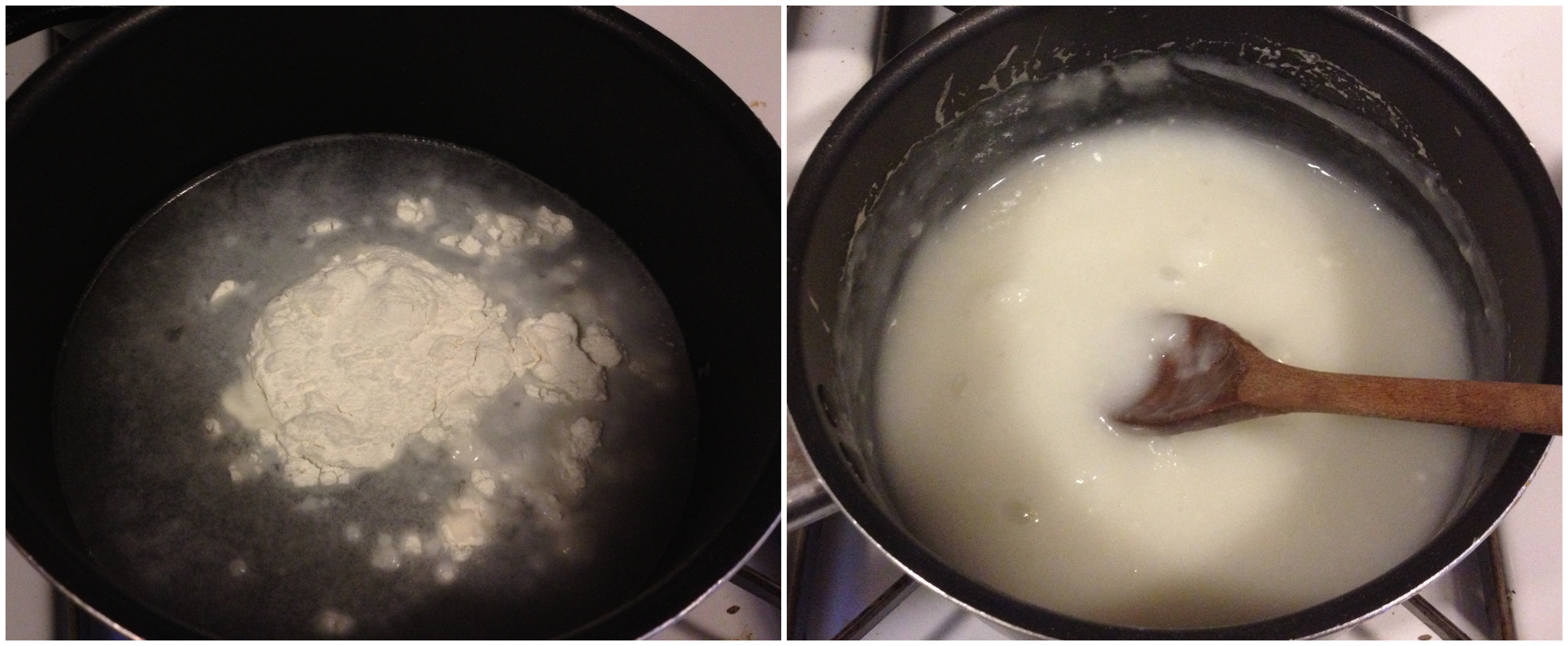
Then you’ll puree some ginger, garlic, and onion:
And add it to the porridge, along with a healthy amount of fish sauce and a kind of incredible amount of Korean red chili pepper:
This Korean red chili pepper is perhaps the most crucial ingredient in kimchi paste — it’s called gochugaru or kochukaru, and kimchi will not taste like real kimchi unless you use it. It looks somewhat like cayenne, but it has a smokier, sweeter flavor and is crucial to a lot of Korean cooking. You can usually find it in large containers in H-Mart or other Asian markets. If you don’t have an Asian market near you, there are 1 lb bags available on Amazon here and here. Here’s the one I used, not that this brand is particularly preferable to any other:
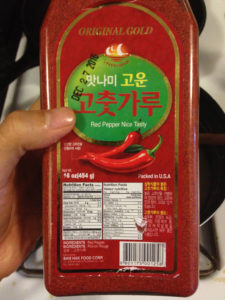
Note that you’ll also need to add fish sauce to the mix. I use Tiparos Thai fish sauce (you can find it here on Amazon) for everything that requires it, and it works wonderfully for this and for things like spicy basil fried rice. Many other kimchi recipes call for some kind of salty seafood in addition to the fish sauce — Maangchi’s recipe calls for squid and sometimes oyster, for instance, and David Chang of Momofuku fame recommends salted shrimp in his recipes. Bowl #2’s mom added some dried anchovies to hers. I didn’t have any of these, so I just used the fish sauce and felt that it was completely fine.
Lastly, you’ll mix in some other chopped vegetables — carrots, green onion, and leek if you have it — before finally coating all the salted cabbage with it. And then you’ll store it to let it ferment and work its spicy/smelly magic!
A few notes about storing and fermentation — as with any canning method, make sure that your hands, your bowls, and your storage containers are clean when making and storing your kimchi. You don’t want any bad bacteria mixing in with the good fermenting kind. If your kimchi smells off (not overly sour, but actually rotten), it’s possible that harmful bacteria got in while you were making it. This can also happen when you under-salt your kimchi. This happened to a jar or two of mine and I was sad!
On fermentation, kimchi will ferment fastest at room temperature and will likely take only a few day to a week to fully ripen. In the refrigerator, it will ferment slower. For kimchi you want to eat soon, ferment it at room temperature first for 24-48 hours (Bowl #2’s mom likes to let it sit in a large bowl of lukewarm water), then eat or store it in the fridge to slow down the fermentation process. For kimchi you’ll want around for awhile, stick it straight into the fridge, then remove small amounts at a time to ferment at room temperature to bring it to the taste you’d like. For this, you can store your kimchi in a gigantic container and remove a bit at a time, like Maangchi does, or you can store it in several containers right off the bat like I did — either because you don’t have a container big enough (me) or for the ease of fermenting batches separately (my excuse). Fresh kimchi can be eaten as banchan, on the side, or in bibim guksu; more sour kimchi can be used in kimchi fried rice, kimchi jjigae, or bindaetteok. And I’m pretty sure any kind of kimchi would rock in a kimchi grilled cheese. Kimchimari has written an excellent explanation on how to ripen kimchi here.
If you end up having some extra paste left over like I did, you can use it for not just cabbage, but cucumber, as below — and this kind you can eat right away! — or daikon. Maangchi includes daikon in her kimchi recipe, but I didn’t include any. If you want to make kimchi from it, be sure to salt it as well before adding the paste.
And without further ado, the recipe! Hope that introduction and the instructions below are explanatory — please, please ask any questions that you might have! I’ll try to answer them as best I can. 🙂 As usual, I halved the recipe to make a smaller batch. This is designed for one head of cabbage and will make about 3 pounds of kimchi. Some aunties make up to 10 pounds at a time!
PrintMak (“Easy”) Kimchi
- Total Time: 2 hours 30 minutes
Ingredients
- 2 very large bowls
- 1 large head napa cabbage, about 2 ½ to 3 lbs.
- 1/4 cup (4 tbsp) kosher or sea salt
- 1 1/2 cup water
- 1/4 cup sweet rice flour (also called mochiko flour, or chapssal garu) (optional, see below)*
- 1/2 cup pureed or minced garlic
- 1 tbsp pureed or minced ginger
- 1/2 cup pureed or minced onion
- 1/2 cup fish sauce
- 1 1/4 cup gochugaru (Korean hot pepper powder), or more or less depending on your spice preference
- 4–5 green onions, sliced into two-inch pieces
- 1/4 cup julienned carrot (optional)
- 1–2 leeks, sliced into two-inch pieces (optional)
Instructions
- Trim off the discolored outer leaves of the napa cabbage. Slice into fourths, remove the core, and chop into bite-sized pieces. Wash thoroughly.
- Soak the pieces of cabbage in cold water, drain, and place into one of the two large bowls. Your next task is to make sure that each piece of cabbage is salted. In order to do this, I worked in batches, putting the cabbage batch by batch into the second bowl and salting each as I went. I used at least 1/4 cup of salt for one head of napa cabbage, if not a bit more.
- After salting, the kimchi will need to wilt in the salt for the next 1 ½ to 2 hours. Every 30 minutes, turn the cabbage over to salt evenly. I just transferred the cabbage from one bowl to the other every 30 minutes.
- After 1 1/2 hours, the cabbage should have shrunken to about half the size it was originally. Rinse the cabbage in cold water several times (I did it in batches in a smaller bowl) to clean it thoroughly, then drain. At this point, taste it to make sure it’s salted enough. If it’s not salty at all, you may need to add more salt and let it soak for a bit longer.
- Next, make the porridge. Combine 1 1/2 cups of water and 1/4 cup sweet rice flour in a small pot over high heat and bring it to a boil. Keep stirring until the porridge makes thick bubbles — about three to five minutes — then take it off the heat and set aside to cool.
- Once the porridge is cool, add 1/2 cup of fish sauce, 1 1/4 cups of gochugaru (depending on your taste), 1/2 cup of minced garlic, 1 tbsp of minced ginger, and 1/2 cup of minced onion to the porridge and mix thoroughly. You can also purée the garlic, ginger, and onion together in a blender or food processor before adding.
- Add the green onions and carrot and mix thoroughly. You can also add leek if you have it.
- Finally, pour the kimchi paste over the drained cabbage and mix by hand until all pieces are well-coated. (Again, I did it in batches.) Finally, store in airtight glass or plastic containers. The kimchi will need to ferment at room temperature for at least 24-48 hours before it is ready to eat. You will know when it’s ready when the lid pops when you open it and you can see bubbles rising to the surface. (It’ll also announce itself with a very strong smell.) If you want to eat fermented kimchi right away, go ahead and leave it at room temperature right after jarring it. If you’d like to keep some for later, put it straight into the fridge without letting it ferment at room temperature. Then, when you’re ready to eat, take it out and let it sit at room temperature for the required time. It will likely only take one day, rather than two, depending on how long it’s been in the fridge.
Notes
*If you don’t have sweet rice flour, it’s fine — all the flour does is help create a porridge to more evenly distribute and infuse the kimchi paste flavor. Just replace the mochiko flour with 1 tbsp sugar to make up for the sweetness.
I didn’t have one single container large enough for all of my kimchi, so I stored it in several smaller jars. I actually think that’s good, in some ways — this way you can put a few jars into the fridge right away, where it can sit for months before eating, and keep one or two out to ferment at room temperature to start eating in one or two days.
Again, please ask any questions about anything that seems unclear — this is such an interesting and unusual kind of cooking! — and I’ll try to answer them to the best that I can with my limited knowledge! And in the meantime, check out these awesome posts — a FAQ on kimchi here, a chart on fermentation by Kimchimari here, and Maangchi’s website in general here. Thank you so much for reading!
If you love kimchi, you may also like:


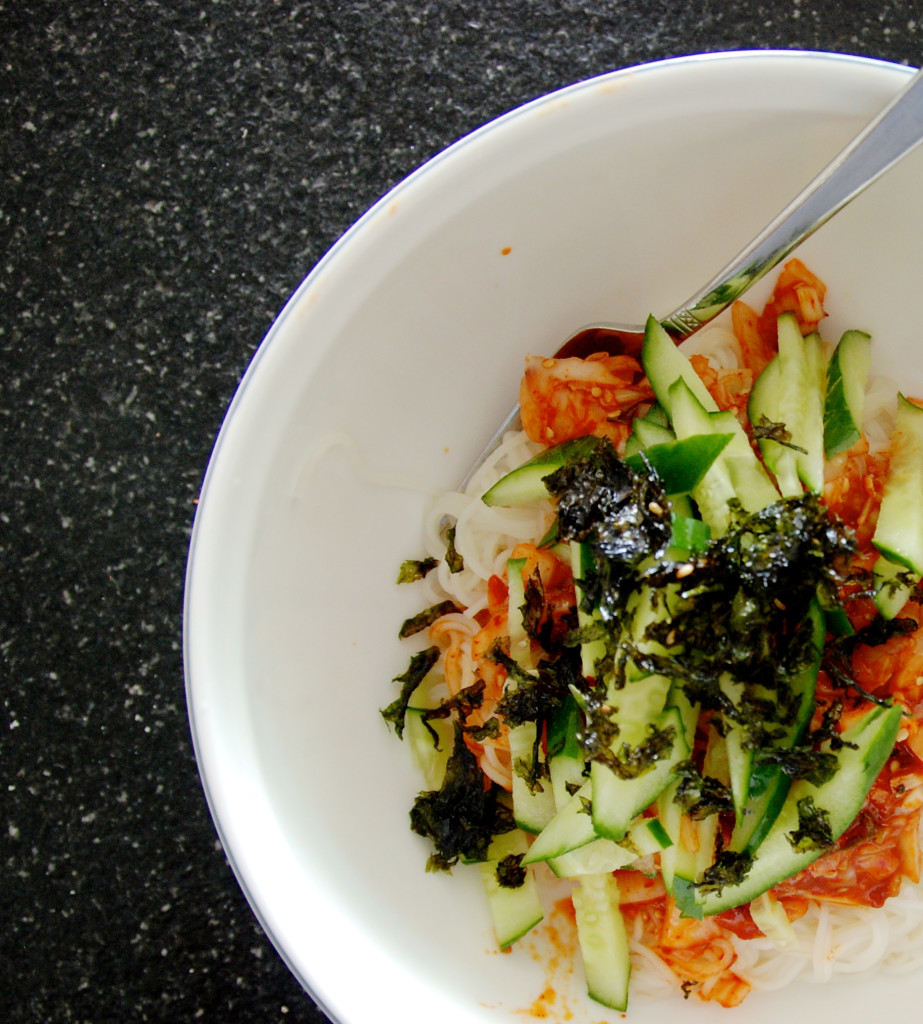

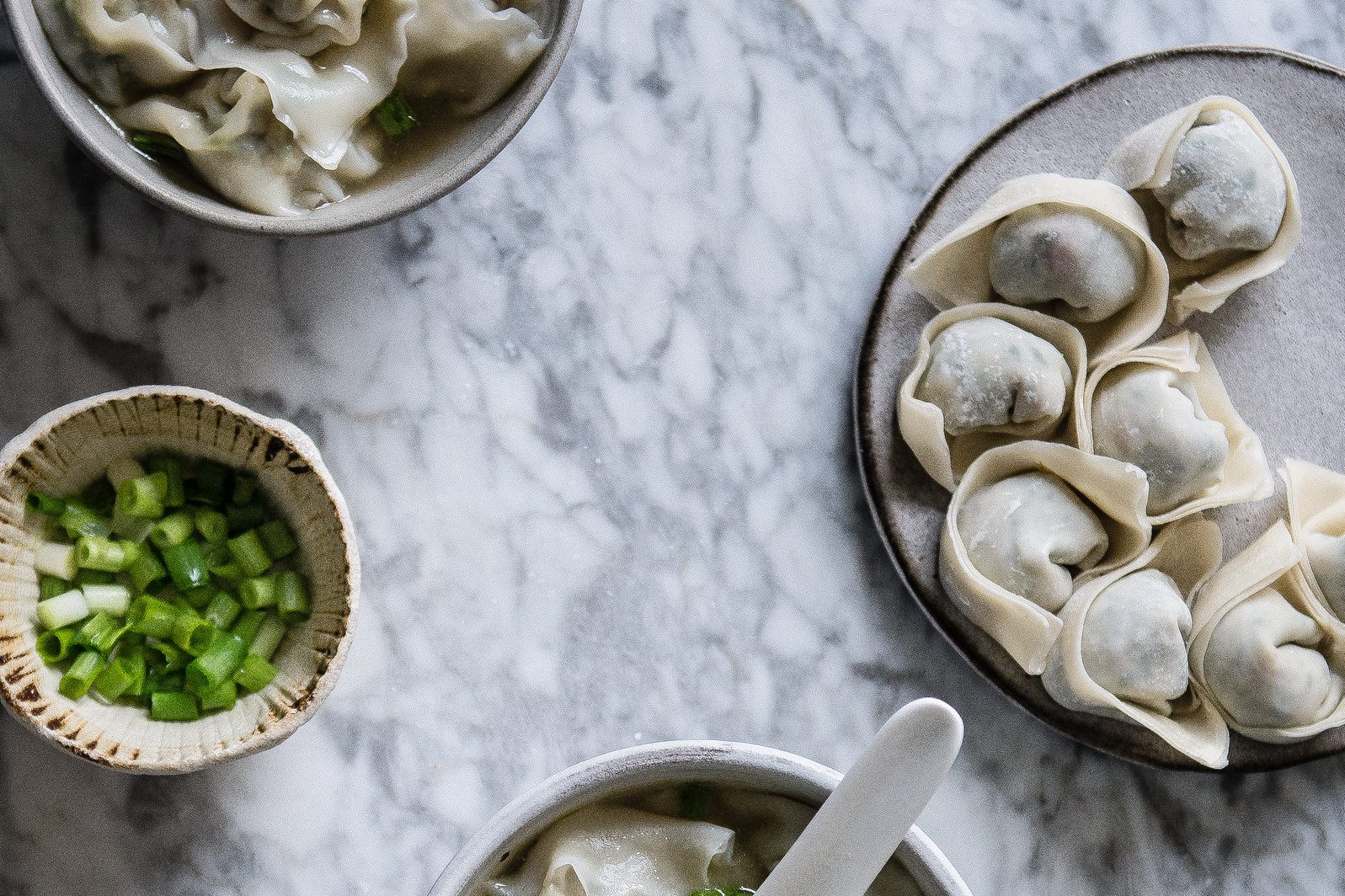


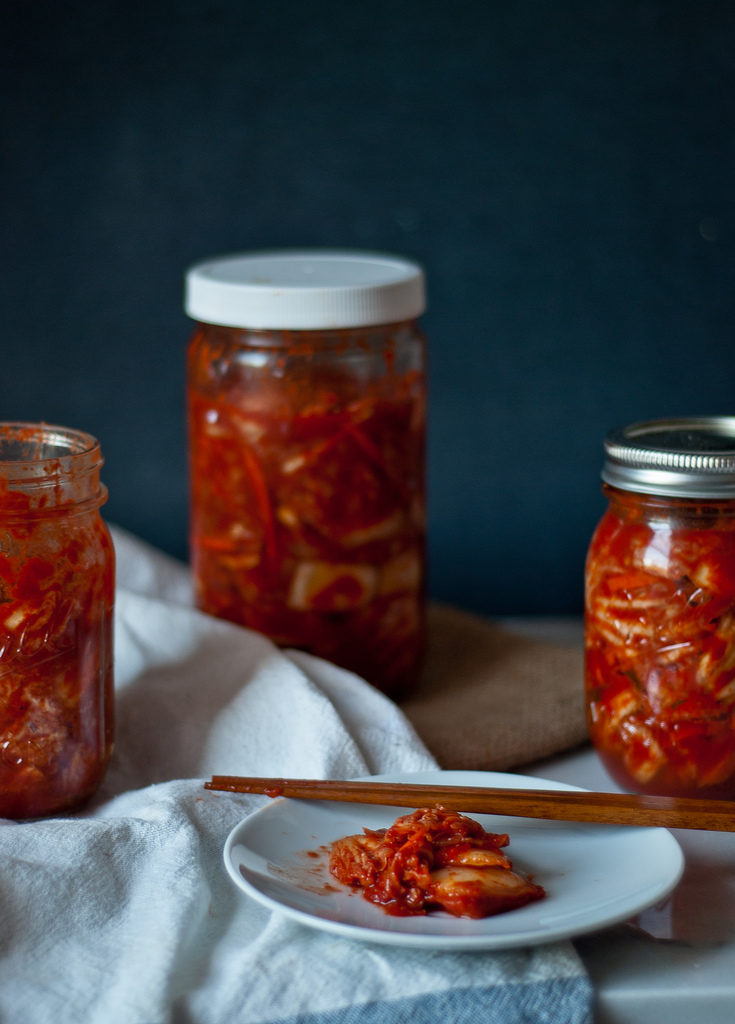

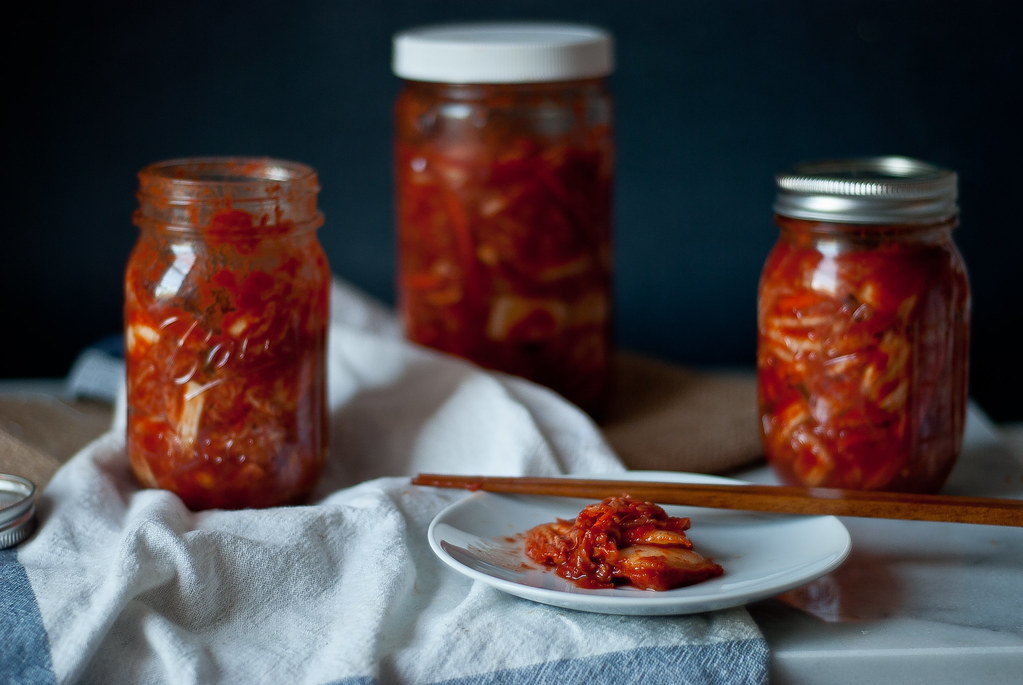

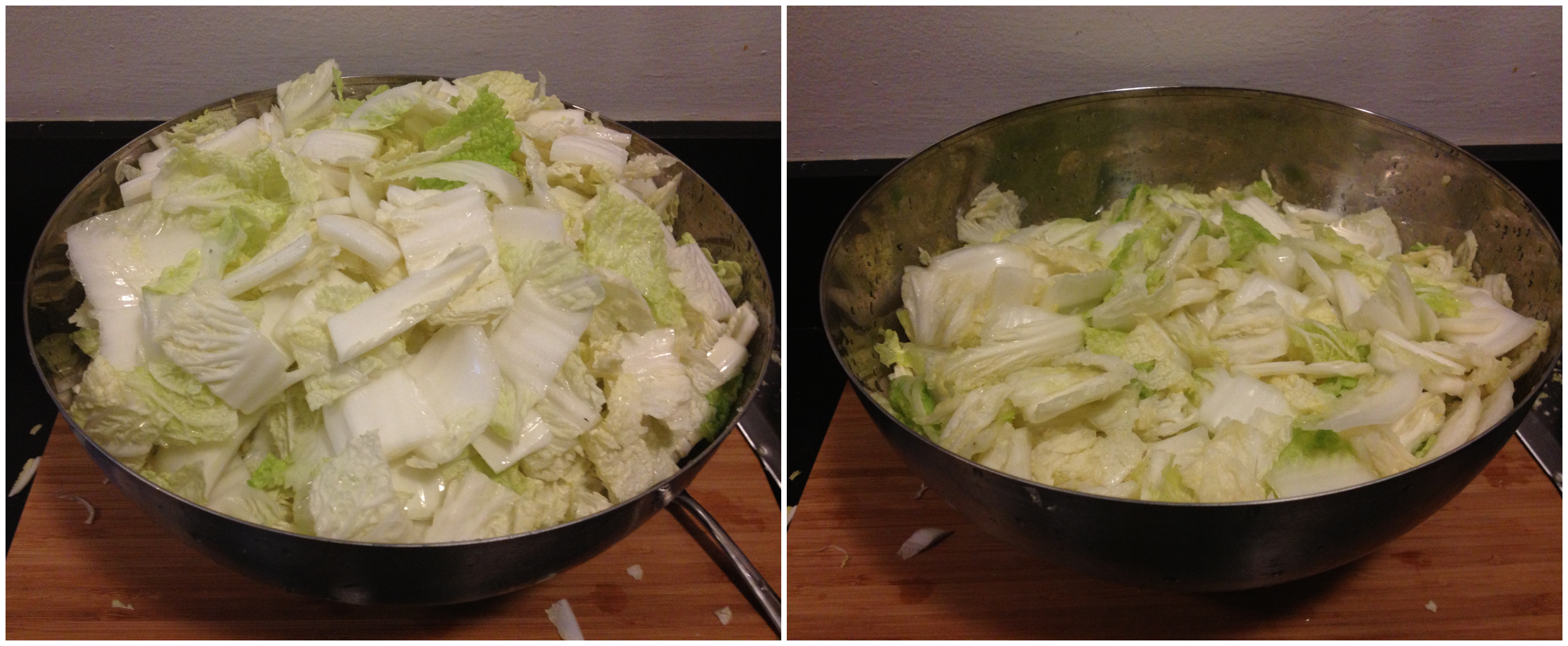
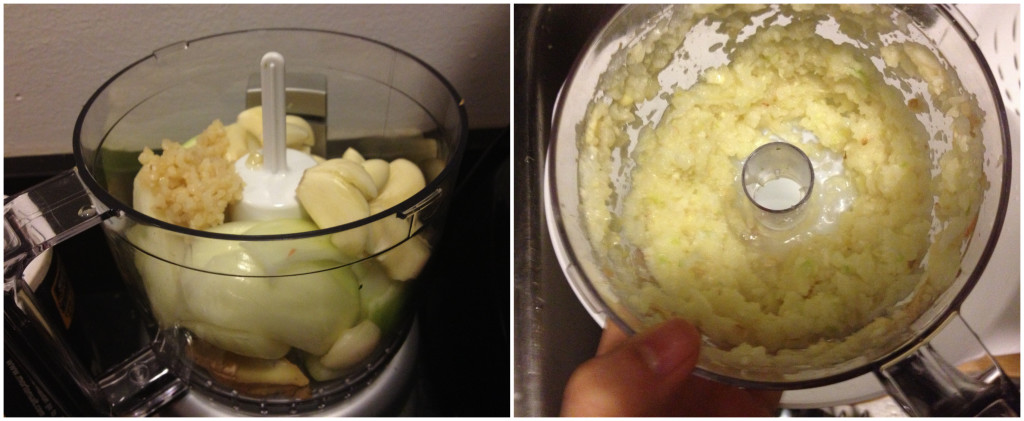
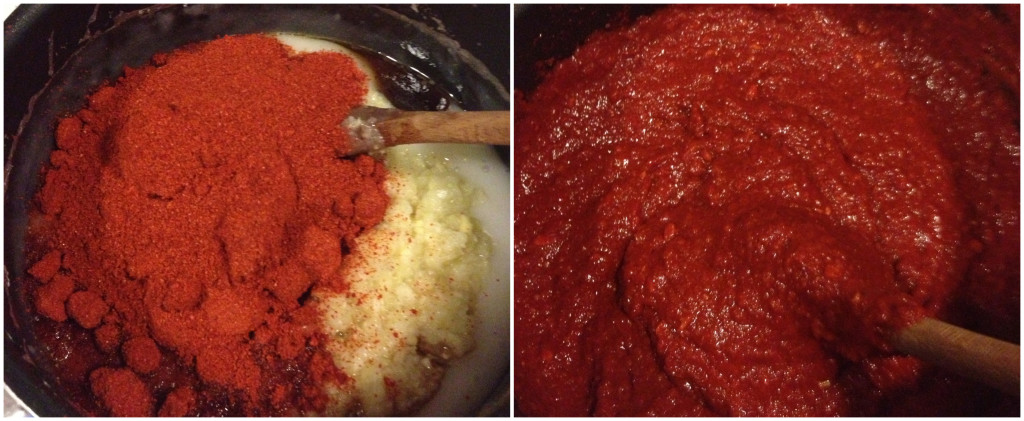
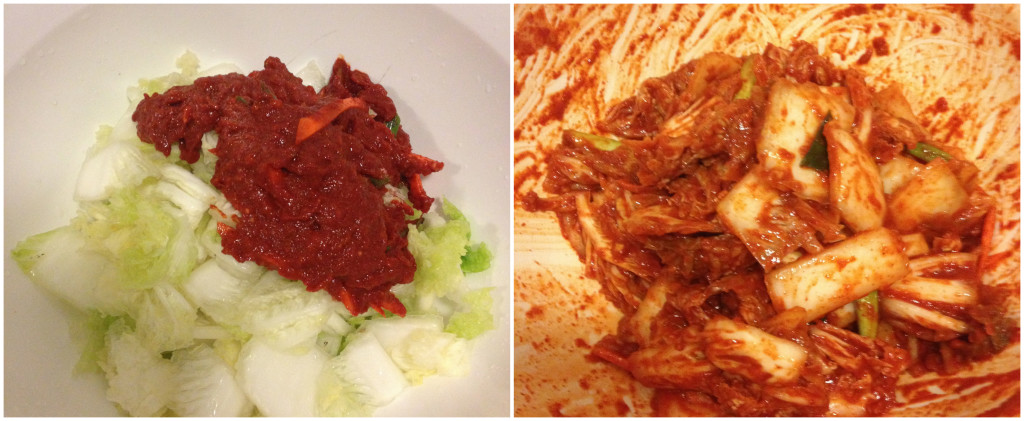


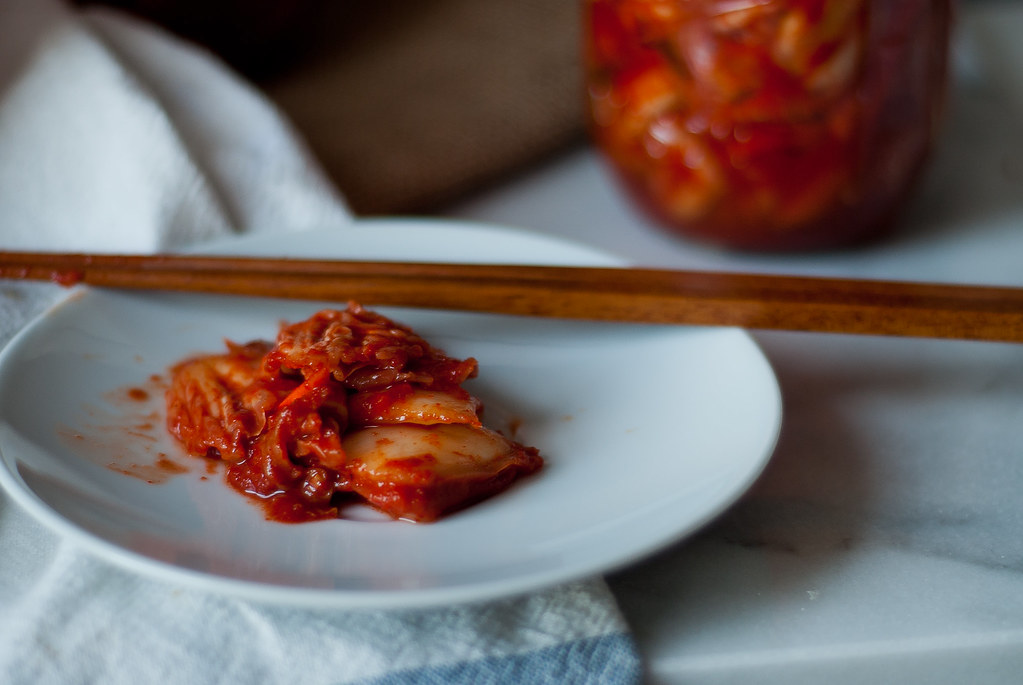
Sara
Growing up in a household where my grandmother made kimchi all my life, it’s interesting to see another take on it. I don’t know exactly how clean her method is (all made in our backyard, what upppp) but! Since she refuses to properly teach me how to make kimchi, this seems like an awesome alternative. Because seriously, what is with the price of sub-par kimchi around here??
tworedbowls
Hahaha I love it! Yes, I’ve heard about burying giant jars of kimchi in the backyard to ferment, though Bowl #2’s parents live in a high-rise, so… I didn’t see that happen firsthand. I don’t know how his kimchi guru uncle makes it, though. And yes, maybe cleanliness isn’t so important for this after all?! I just had a jar or two smell bad (and the real kind of bad, not the “no, that’s how it’s supposed to smell” kind!) and I suspect it was either because we ate straight out of it a few times or I was a bit too rough with the cabbage.
But seriously. Kimchi around here is sad and depressing. I obviously have no family heirloom recipes passed down from generation to generation to share, but I just figured I had to put something in case anyone was like us and was desperate for some kimchi that was — you know — actually spicy!!
Sara
Oh no! To be honest, having never made it, I have no idea…but this method sounds so easy. And hey, if it’s cheaper, I’m all about it. I am unashamedly arguing that we have a kimchi making party soon.
tworedbowls
Who knows! I plan to use more salt next time because I thought it could have used it, and that may do the trick, too. And um, yes!!! If I ever have the time, I would LOVE a kimchi party. 🙂
Jessica @ Food Luv Bites
You have no idea how excited I am to make this 😀
tworedbowls
I am so excited (well, and a bit nervous!) for you to make it too!!! I feel a little like the blind leading the blind, so I hope it turns out well. Please let me know how it goes if you try it!
Ruthy Kirwan
Having never made kimchi (or gotten the courage!) this looks like something I could actually do. It can’t be much harder than making pickles, right? And your photos turned out gorgeous!
tworedbowls
Haha, if you’ve made pickles I feel confident you could make this — because I’ve never pickled anything! And thanks SO much, Ruthy. I always feel like there’s something that I could have done better with my photos, so it means a lot to hear that! Let me know how the kimchi goes if you ever try it 🙂 It’s still quite an endeavor (you should have seen my kitchen when it was all done) but super fun, and worth it in the end!
chef mimi
Oh my god this is beautiful stuff! Wish I could make it with the real ingredients…
tworedbowls
Aw, thank you so much, Mimi! Yes, the upfront investment in a big bag/box of the red pepper powder was daunting for me. The upside is that it lasts forever and is pretty versatile in a lot of Korean cooking. And the fish sauce is obviously great in Thai. I think you’d find uses for both if you ever decided to get them (but it took me awhile, too).
chef mimi
Hi there! I just nominated you for the Liebster Award. You can read all about it here:
http://chefmimiblog.com/2013/12/05/awards-2/
I don’t know if you get involved with awards, but you can do with it what you want. No rules, as far as I’m concerned! I just wanted my followers to become familiar with your lovely blog, if they weren’t already. Merry Christmas!
ela@GrayApron
Wow, I’m deeply impressed 🙂 ela
tworedbowls
Don’t be, Ela! 🙂 It’s really pretty easy. Thank you so much, though!
tinywhitecottage
This is a wonderful post! I can’t tell you how impressive this really is. Seriously, not many would rise up for the challenge and not only make kimchi but post the process! Brilliantly done. Oh geez, now I want some kimchi!
tworedbowls
Haha, aw! You flatter me! I don’t know how impressive it really is! And honestly it was born of necessity, I don’t think I would ever have dared try it if there was any way we could get decent storebought kimchi. But the kimchi around here just isn’t spicy at all, and for the price I had to figure out an alternative. If you try it, I think you’ll find that it’s pretty manageable after all, too! 🙂 Thank you so much for your wonderfully kind words.
Lan | morestomach
it kinda breaks my heart, i purchase kimchi from whole foods, it’s organic but it’s not good. AND THEN, my husband confessed to me the other night that he doesn’t like kimchi. i’ve had it on my bucket list to make eventually, but now i don’t think i can, cus i cannot be the only person in the house eating the stuff.
unless there was a way to make it super small batch? is that even possible?
tworedbowls
You know, it could be possible!! I actually just saw some bizarrely small napa cabbages in the supermarket the other day and was thinking to myself that that would have worked for a smaller batch. Plus, I find that it’s okay to have a larger amount of homemade kimchi at first because it ferments so slowly in the refrigerator that you could just shove it back there and literally forget about it for weeks. Maybe if you could get your hands on a 1 lb napa cabbage and halve the paste recipe above, you could try it out 🙂 Thanks so much for stopping by, Lan! I adore your blog!
Allison (Spontaneous Tomato)
Lan, your husband doesn’t like kimchi? What if that’s just because he hasn’t tried your own homemade kimchi… YET?!? If you make it, you might actually get some help eating it after all…
(Also I think the gateway drug for kimchi skeptics is sauteed kimchi, like in kimchi fried rice. Does he even not like it like that?)
tworedbowls
(Poking my head into this parenthetical to say this is SO true, Allison! Sauteed kimchi is absolutely the slippery slope into fermented addiction. It’s how I got hooked!)
Sugar and Cinnamon
I love kimchi but I’ve never made it before! This recipe looks so easy and yummy though I think I’m going to try 🙂
tworedbowls
Oooh, let me know how it goes if you do! This is one recipe where I’m especially curious to see how other people’s experiences go. Though I’m really hoping I don’t lead anyone astray… 🙂
Allison (Spontaneous Tomato)
Oh my gosh, beautiful photos and such lovely detailed instructions! (I love your blog re-design, too! Someday I hope mine looks half as nice…)
I’ve only ever made kimchi the whole-cabbage way (when I was living in Korea and we had a separate kimchi refrigerator…), not the “easy” way. Although the easy way still seems pretty time intensive, huh… not to say it’s not worth it! You’ve made me think I should give some mak kimchi a try, though! Also I had no idea that you could immediately put it into a fridge and then remove some to ferment small amounts at room temperature at a time– that’s an awesome & useful tip!
Oooh and I love oi-gimchi and kkakdugi, too!!! The next time I make homemade kimchi, I’ll be sure to have some cucumbers and daikon around the house just in case I have extra rice/chili paste!
tworedbowls
Allison, I’m so flattered! I think mine has a long way to go, but that means a lot coming from you.
And ha, yes — I guess it’s just a little easier by comparison! I kind of just assume it’s easy too because I was able to make it. So impressed that you make it the whole-cabbage way, that seems intense, to say the least. Major, major props to you! Thanks so much for your kind comment 🙂 I’d love to hear how you make your kimchi, I’m sure I could learn a lot from you!
Oh, and I’m right there with you, I SO love oi kimchi, especially. This paste was fantastic on it!
Allison (Spontaneous Tomato)
Oh I wouldn’t be so impressed with me if I were you… haha. 🙂 Because when I made it the whole-cabbage way, it was totally under the guidance/direction of my “kimchi seonsaengnim” (kimchi teacher) who was the mom (and experienced kimchi-maker) of a friend of a friend. It was awesome and I learned a lot that day, and took a lot of photos, etc., but I still haven’t tried it again on my own—and that was in 2008!
I think the whole-cabbage way is worth it if you have the space to store several whole cabbages packed into a container together at once. They do take a really long time to salt though—I think we salted them for more like four or five hours. We also stuffed/smeared them with a mixture of rice paste, chili, ginger, and garlic, along with buchu (garlic chives that look similar to scallions) and julienned daikon. I don’t remember using any fish sauce.
Actually we made kkakdugi and oi-gimchi too (with the same chili mixture), but our oi-gimchi were in a slightly different shape than the ones in your photo above—it was like we were trying to make whole-cucumber kimchi along with the whole-cabbage stuff: we quartered the cucumbers lengthwise, but not all the way down the whole length of them—we left one bottom end intact to hold them all together. Then we stuffed them and packed them into a big plastic container with their quartered small ends up.
tworedbowls
A kimchi teacher! I love it. I bet you could make it again. If you do, I’ll be so excited to see your take. And I totally agree with you, I’ve always heard whole cabbages make the best kimchi. How long were you in Korea? I want to go with Bowl #2’s mom at some point.
And YES, the way you made oi-sobaegi is the right way!!! They’re supposed to be made with Kirby cucumbers (which are much smaller) and stuffed, not like I did it. I just happened to have regular cucumbers around and wanted to use up the paste. Yum… I think it might be my favorite kind.
Allison (Spontaneous Tomato)
Yeah, you’re right, I could make it again… but I will wait until I have more optimal conditions (i.e., fridge space or a hangari—a ceramic kimchi fermentation crock). I should totally make cucumber or daikon kimchi sometime soon though, because they would take up way less fridge space, and they are way less easy/impossible to find in stores around here compared to paekchu kimchi!
I was in Korea for about 3 months taking baby Korean language classes (on a summer fellowship, since I thought I might pursue research in Japanese/Korean comparative linguistics), and then I’ve been back to visit for 7-10 days um… twice since then I think? I can’t even remember now! I am soooo lucky because I have some good family friends who are Korean and have a house in Seoul that I could stay in.
Milk and Honey
Fantastic post. I adore kimchi. And when Alison (Spontaneous Tomato) mentioned sauteed kimchi, my mouth watered.
tworedbowls
Right?! It was definitely the gateway for me. Once, I sauteed kimchi in butter to put in a quesadilla — game. over. Unbelievable. Thank you so much for your comment! :):)
Mandy
OH MY! THESE LOOK CRAZY GOOD! But if I make these my fridge will stink for like… 6 months!!
tworedbowls
Hahaha, or it will smell like a fermented WONDERLAND!
Mallory @ Because I Like Chocolate
I am currently reading Roy Choi’s book “L.A. Son” and it was reminded me that I really want to make kimchi. I like this recipe because unlike his, it is vegetarian (well minus the fish sauce but that’s ok)!
Two Red Bowls
Haha! Silly fish sauce… Yes, I did like that this recipe turned out okay without the squid, oysters, or anchovies. I was a little squeamish about handling squid or oysters since I never cook it generally and I’d have no idea about whether it was good to eat. I hope you have fun making this if you try it, Mallory!!
J.Lee
like pita, naan, and tons of other multistep foods, the process of making kimchi is something that gets waaaay more easy the more you make it. and the taste totally improves. i like my kimchi fresh, sweet and extra garlicky. it’s always ready for jeon by the time i bring it home from stores- completely sour. we soak our cabbage in salted water overnight- i know it’s not typical but it’s less work than turning it and the water evenly distributes the salt. so lazy! lol. see, it gets easier.
Anna @ Lunchlife.org
I’ve been so eager to make this and finally got together all the ingredients from my local Asian supermarket, but I’m confused about the Korean hot pepper. I couldn’t find anything called gochugaru and went for something called ‘sawan’ chili paste, but I’m worried that it’s totally the wrong thing. Could anyone make suggestions of good substitutes if you can’t get the right ingredient, or could you suggest what other name it might be hiding under? I really want to try this!
Cindi
To make this vegan, we’d have to leave out the fish sauce. I’m wondering how big a difference that would make. The kimchi I bought at the health food store didn’t list any in their ingredients, but I don’t know what real kimchi tastes like anyway. I’ve never seen the flour trick in any other recipe I’ve looked at. I really want to try this, but I’m such a chicken. I’ve already bought my Korean chili powder.
tworedbowls
Hi Cindi! I just did a quick Google and looks like Serious Eats has done a test on how to make vegan kimchi without fish sauce or other seafood here: http://www.seriouseats.com/2012/01/vegan-kimchi-as-good-as-the-real-thing.html Kenji suggests adding a few tablespoons of miso paste instead of fish sauce in his recipe (http://www.seriouseats.com/recipes/2012/01/homemade-vegan-kimchi-recipe.html) and some daikon radish. Hope that helps!
rachell
thank you! This was so informative. I’ve made quick kimchi before but not the fermented kind. I guess the part that always seemed unclear to me was just HOW long to keep it at room temp before refrigerating it. What I took away from this is that 1-2 days is sufficient, but that it then won’t last as long as kimchi that you refrigerated from the start. It’s confusing because I’ve read the opposite. All the contradictory information on this subject has stalled my kimchi game! No. more. I’m plunging ahead on this and nothing can stop me!
Kat Boeck
For the salted seafood, as I have a allergies to shrink and octopus, is it possible to use salted herring insted? Or what might be some other substitutes?
tworedbowls
Hi Kat, sorry for the delayed reply–yes! Definitely okay to use another salted type of seafood. My mother-in-law uses dried anchovies. I usually don’t use any dried seafood at all, and just opt for fish sauce.
Kathy wills
Well this looks do-able. I guess it all depends if I can find the “goch” first. I keep stopping at the kimchi display at Costco but never actually put it in my cart. I always stalk other shopping carts while in the cashier lineup and have never ever seen it in anyone’s cart.
Aisha
Hey! Thanks for the recipe but I have a question. For the porridge without the sweet rice flour, did you just use water and sugar or also added some kind of flour?
Mike
Any reason you can’t substitute AP flour for the sweetened rice flour rather than just water and sugar?
Susan
The kimchi recipe I use always does not call for the red chili powder or paste. I’ve often wondered why mine is not red like the others! Is it ok to use fermented red chili paste? I have this on hand .. also just made mine new batch, not bubbling yet and wonder if I can add this now? Re-stir and continue to let set to ferment?
Stéfanie
Hi there! Just wanted to pop on here and leave a comment since I’ve been using this recipe (and some of Maangchi’s tips) to make kimchi since 2020. Thank you so much for putting this together. My family and I love this kimchi and prefer it to any we’ve tried. I just wanted to note that when I started making this recipe I didn’t have sweet rice flour, so I ground up oats to make oat flour – worked just as well as a substitute. I also have a few vegetarian friends, so I often leave out the fish sauce and have no issues either.
Best wishes to you and all your readers!
★★★★★
Renee Milton
I want you to know that the idea of making my own kimchi was, at first, daunting! But your easy to follow instructions gave me the courage to do it! And it turned out great! I have shared jars with my friends with no complaints (other than “my jar is empty! Please refill!”). Now, I have lost count how many times I’ve made kimchi with your recipe. If you still have doubts about your recipe, doubt no more!!!
★★★★★
Verlin Smith
Capture sales when to know how to make it thank you